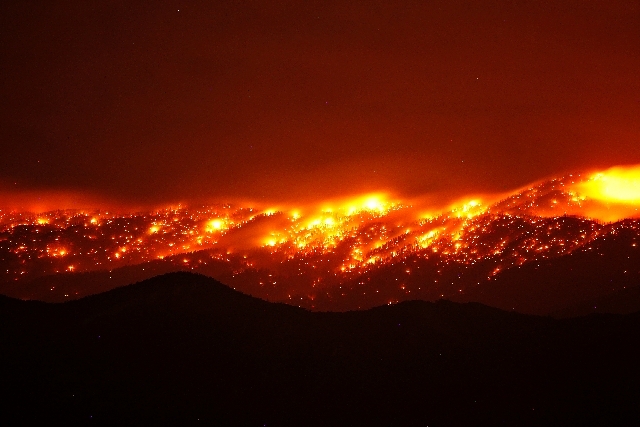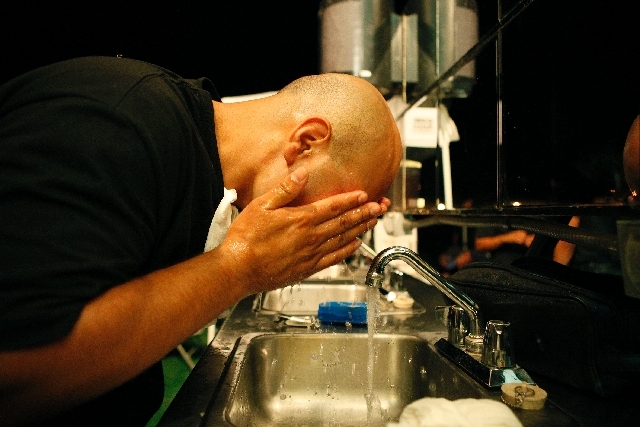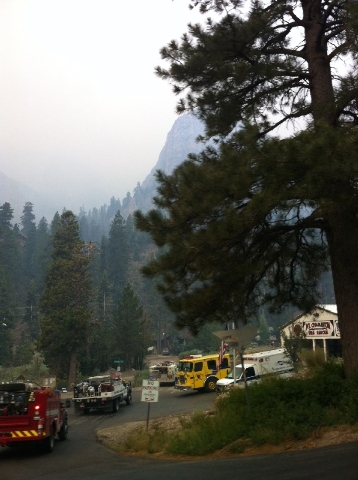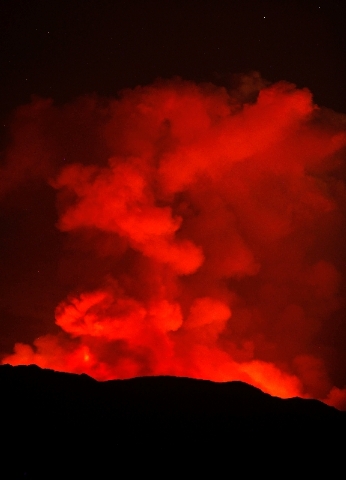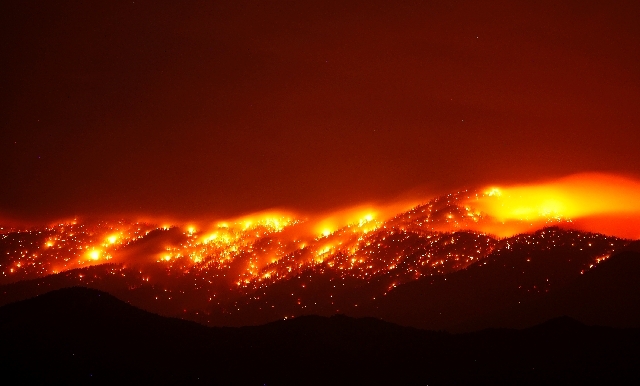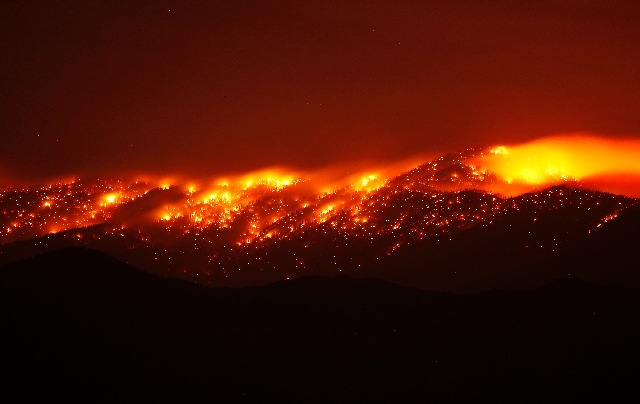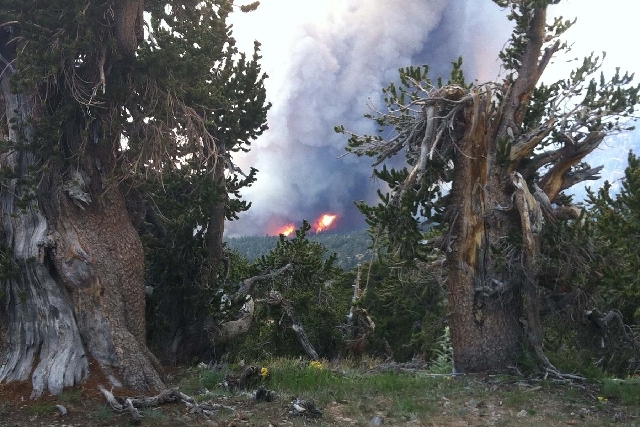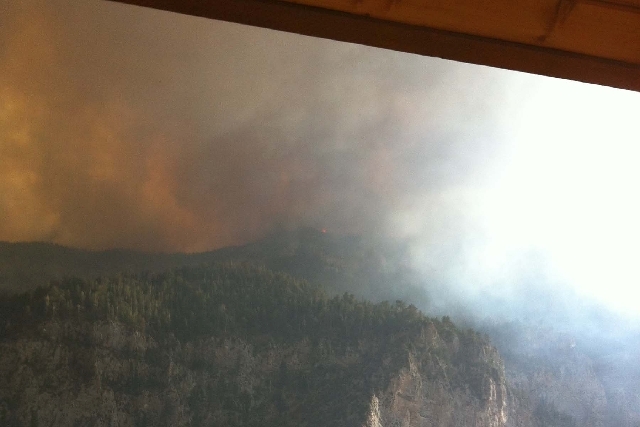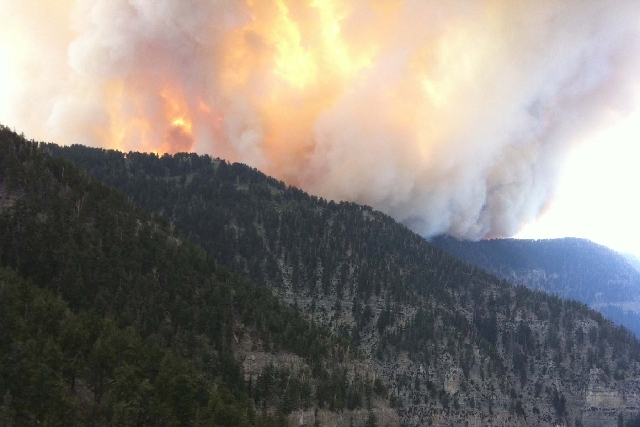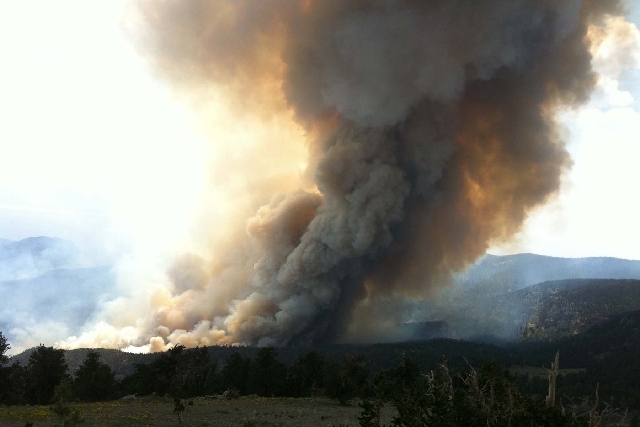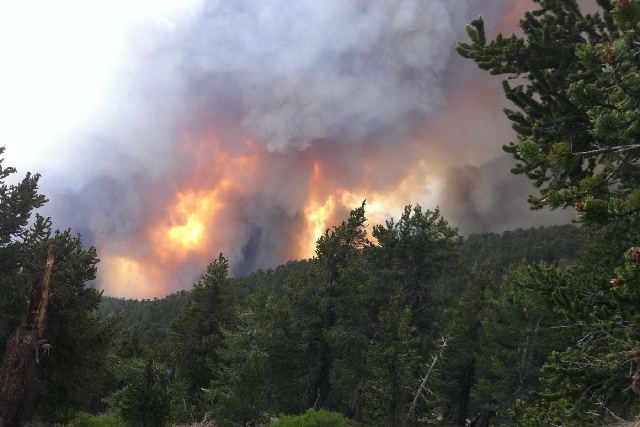Carpenter Canyon scorched; firefighting forces moved to Kyle Canyon
Crews battling the wildfire that consumed Carpenter Canyon on the west side of the Spring Mountains switched their focus to the small community of Kyle Canyon to the east on Saturday.
Members of a second incident management team — a Type 1 team with more experience and resources — arrived in the afternoon at Centennial High School in the northern part of the Las Vegas Valley, where they set up an incident command post. The team of 50 to 55 was set to take over part of the fire early this morning.
The Type 1 team was called in by the Humboldt-Toiyabe National Forest because “the fire has increased in complexity.”
A public meeting is being planned for this evening to update residents on fire operations and evacuations.
U.S. Forest Service officials said the lightning-caused Carpenter Canyon fire that started Monday grew to 14,108 acres by Saturday evening, reaching the summit and threatening to drop into Kyle Canyon where most of the mountain’s homes are located.
The fire was 5 percent contained as of Saturday evening, said Jay Nichols, spokesman for Spring Mountains National Recreation Area.
A longtime Mount Charleston resident said this is the worst fire he’s seen in two decades.
No injuries or damage to structures was reported in Kyle Canyon.
A small spot fire caused by embers from the big blaze was reported within a mile of the Rainbow subdivision and its dozens of homes. And a small, isolated fire flared up sometime Friday night or early Saturday on the eastern side of Harris Mountain to the east of the main fire. Concerns were raised that this smaller fire could spread, Nichols said.
While Harris Mountain is being watched and some crews remained on the western side protecting Trout Canyon homes, most of the 628 firefighters have moved to the Las Vegas-facing side as the fire crept over the Charleston summit.
Most of the 12 hot shot crews, 26 engines, and five helicopters and tankers working the wildfire switched their focus from Carpenter Canyon, which was wiped clean. Only hot spots remained, according to information gathered by a plane that flew overhead mapping the area with an infrared camera.
John L. Smith, a Las Vegas Review-Journal columnist who has lived at Mount Charleston for 23 years, said the mountain community has had close calls in the past, but nothing like this fire.
“This is definitely the most serious fire that I’ve experienced in the time that I’ve lived here,” he said. “It’s the largest in terms of acreage.”
TYPE 1 TEAM FOR A COMPLEX FIRE
Officials said Friday they were turning Centennial High School into the incident command post in a move to keep resources close to the threatened structures in Kyle Canyon.
Brandon Hampton, a spokesman with the Type 1 team, said it was called in because “the fire has increased in complexity.” The complexity of the fire includes the fact that it spread rapidly on Friday and the steep and rocky terrain in Kyle Canyon is not very accessible, making it difficult for firefighters to safely get there to fight the flames.
“We want to keep it (the fire) out of Mount Charleston and out of homes,” Hampton said.
The Type 1 team will take over the fire on the Las Vegas side at 6 a.m. this morning, said Jack Horner, another spokesman with the team. The Type 2 team will continue to handle the fire on the Pahrump side.
“They will work together,” Horner said of both teams. “They will share resources and crews might move back and forth.”
The incident management teams develop a plan of attack for the fire personnel to follow while battling the fire, Horner said. “They say, ‘Here’s what we are going to do and how we are going to do it,’ ” he said.
The difference between the teams varies, but sometimes members of a Type 1 team have more experience and more resources, Horner said. There are about 16 Type 1 teams in the country.
A Type 1 team is usually deployed for 14 days, but at this point it’s unknown how long the team will be here.
“It could be three to four days or it could be two weeks,” Horner said.
How long the team stays and how long it takes to contain the fire will also depend on the weather.
“I think we are confident, but there are other factors that go into confidence,” Hampton said.
A public meeting will take place at 6 p.m. today at Centennial High School. Horner said the meeting is for families who have been evacuated and members of the public who want to get an update on the fire.
Members of the Type 1 team will be available to provide information about fire operations and to take questions from the public.
LUCKY WITH WEATHER
A stroke of good fortune greeted firefighters waking Saturday morning to an overcast sky.
Last week’s record high temperatures will give way to cooler, more humid weather this weekend, said Mark Struthwolf, a National Weather Service meteorologist who arrived Friday from Salt Lake City to advise the firefighters. It’s his second fire of the season, having advised a crew battling a small fire near Moab, Utah.
“My job is to sift through observations coming from the field,” he said.
The chance of thunderstorms, like the one that started the fire, is minimal but the change of weather will bring erratic winds in the canyons gusting in any direction at 25 to 35 mph, he said.
The strong winds from the south that spread the fire so quickly last week were expected to die down to 10 mph by 6 p.m. Saturday, Struthwolf said. But the winds will continue to push the fire down the Las Vegas-facing slope toward Kyle Canyon homes where crews were waiting and spending Saturday clearing the area of brush and other dry fuel, Nichols said.
As of Saturday afternoon, shortly after 2 p.m., a small spot fire north of the main fire was growing in Rainbow Canyon, within a mile of the Rainbow subdivision, where some structures are located, Nichols said.
Fire teams are protecting those structures, he said.
In general, they remove wildland and fuels around the homes, anything that would help prevent the fire from progressing, he said.
But Nichols said officials were concerned about the winds Saturday.
“We are concerned with the wind and we have issues with the weather every day,” he said. “We are doing the best that we can.”
AIR QUALITY ALERT CONTINUES
Because of the fire, the Clark County Department of Air Quality extended a health advisory for smoke and ground-level ozone through today around Las Vegas.
Access to Mount Charleston remained limited Saturday. State Route 156 into Lee Canyon and state Route 157 into Kyle Canyon remained closed at U.S. Highway 95. Trout Canyon and Lovell Canyon roads also were still closed.
Meanwhile, in Northern Nevada, crews were hampered by sustained winds and low humidity as they fought a wildfire that had grown to more than 7,000 acres, or 11 square miles, in the Pine Nut Mountains near Gardnerville, 60 miles south of Reno. The blaze was only 20 percent contained Saturday.
No injuries or damage to structures were reported, but residents of about 20 homes remained under a voluntary evacuation notice.
More than 300 firefighters were battling the blaze, which posed a severe threat to critical sage-grouse habitat. Officials are working across the West to keep the chicken-sized bird off the federal list of threatened and endangered species.
Reporters Steven Slivka and Annalise Porter and The Associated Press contributed to this report. Contact reporter Yesenia Amaro at yamaro@reviewjournal.com or 702-383-0440. Contact reporter Trevon Milliard at tmilliard@reviewjournal.com or 702-383-0279.
FIRE INFORMATION
Spring Mountains Recreation Area:
• www.inciweb.org
• 702-515-5105
SUNDAY FIRE MEETING
Time: 6 p.m. Sunday
Location: Centennial High School, 10200 W. Centennial Parkway
Video
Fire in Kyle Canyon
This video was shot by Robert Pernett about 11 p.m. Friday from U.S. Highway 95. The view is up Kyle Canyon Road.



